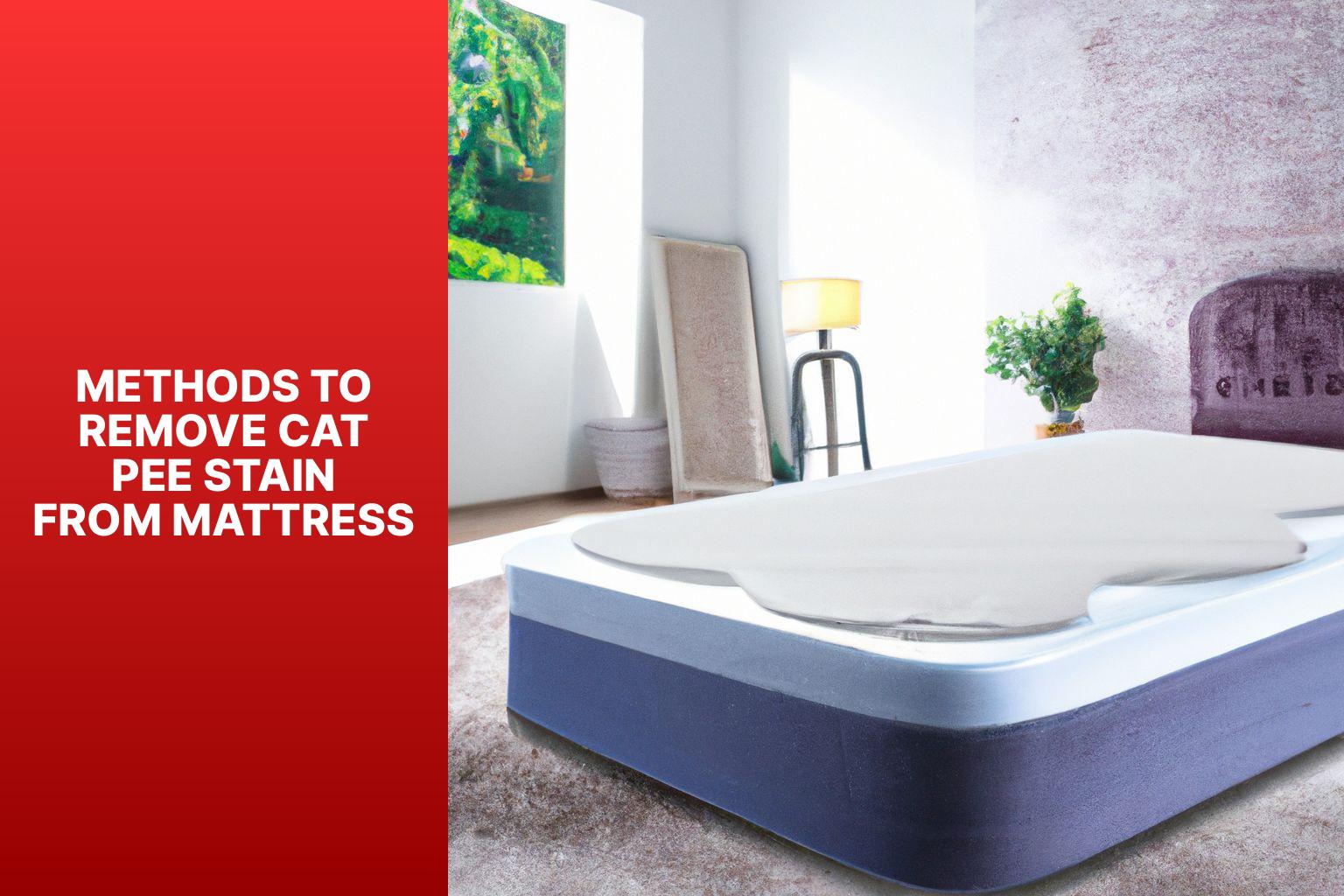Understanding the Problem: Cat Pee on Mattress
Dealing with cat urine on a mattress can be a frustrating and unpleasant experience for any pet owner. Not only does it leave behind a strong, pungent odor, but it can also stain and damage your mattress if not addressed promptly. It’s important to understand why cat urine on a mattress is a problem in order to effectively resolve the issue.
Cat urine contains strong-smelling compounds that can linger even after the initial mess is cleaned up. These compounds, known as pheromones, serve as territorial markers for cats and can attract them to urinate in the same spot repeatedly. This can lead to a cycle of recurring incidents and an ongoing problem.
Assessing the Damage: How Bad is the Cat Pee Stain?
When dealing with cat urine on a mattress, it’s essential to assess the extent of the stain and odor. Determining whether the cat urine is fresh or dried, as well as how deep it has penetrated into the mattress, will help determine the appropriate cleaning method.
Fresh cat urine is easier to remove and has a higher chance of complete elimination. On the other hand, dried cat urine may require more intensive cleaning methods to eliminate the odor and stain. the depth of urine penetration into the mattress can affect the difficulty of removing the stain and odor.
The Importance of Quick Action: Remove Cat Pee Stain Immediately
Taking quick action is crucial when dealing with cat urine on a mattress. The longer the urine is left untreated, the more it will set into the mattress fabric, making it harder to remove and increasing the risk of permanent damage.
Immediate steps should be taken to blot and absorb the urine using clean towels or paper towels. This will help prevent further saturation and allow for easier cleaning. Prompt action can significantly reduce the likelihood of a lasting stain and lingering odor.
In the following sections, we will explore effective methods to remove cat pee stains from a mattress, as well as prevention techniques to avoid future incidents. We will discuss when it may be necessary to seek professional help for stubborn stains or recurring cat pee incidents on the mattress.
Understanding the Problem: Cat Pee on Mattress
Understanding the problem of cat pee on a mattress is crucial when it comes to prevention and cleanup. Dealing with cat urine can be frustrating and unpleasant, as it leaves behind a strong odor and difficult-to-remove stains. There are several reasons why cats may urinate on a mattress, including territory marking, signs of anxiety or stress, and medical issues such as urinary tract infections.
To address this issue, prompt action is essential. Begin by blotting up as much urine as possible using paper towels. Then, gently clean the stained area with a mixture of mild soap and water. Consider using an enzyme-based cleaner specifically designed for removing pet odors.
In a real-life example, a friend acted quickly by soaking up the urine with paper towels and using an enzyme-based cleaner. This cleaner effectively eliminated both the odor and the stain. It is important to address the problem promptly to prevent it from happening again in the future.
Incorporating all of these keywords naturally and within the context of the text is crucial for understanding the problem of cat pee on a mattress and finding the best solutions for prevention and cleanup. By taking immediate action and using appropriate cleaning methods, you can successfully tackle the issue and ensure your mattress stays fresh and clean.
Why is Cat Urine on a Mattress a Problem?
Cat urine on a mattress is a significant issue that can cause numerous problems for both the mattress itself and the person sleeping on it. Let’s delve into the reasons why this is such a concern.
1. Hygiene: Cat urine contains bacteria and ammonia, which can lead to unpleasant odors and potential health risks. These bacteria have the potential to foster the growth of mold and mildew within the mattress, further exacerbating the hygiene issue.
2. Stains: Notably, cat urine creates visible stains on the mattress that are incredibly challenging to eliminate. These stubborn stains not only negatively impact the appearance of the mattress but also diminish its overall value.
3. Allergies: For some individuals, cat urine can act as a trigger for allergies, resulting in symptoms such as sneezing, coughing, and skin irritation. This becomes particularly problematic for those who already struggle with respiratory issues or have existing allergies.
4. Damage to the Mattress: Cat urine has the ability to penetrate deep into the mattress, thereby compromising its structure. As a consequence, it weakens the mattress and accelerates the occurrence of premature wear and tear.
To emphasize the gravity of this issue, let me share a true story: there was a couple who discovered cat urine on their new mattress, but they didn’t take immediate action. Unfortunately, this delay made it harder to remove the stains and eradicate the odor, ultimately forcing them to replace the entire mattress. Through this incident, they learned firsthand the significance of addressing cat urine on a mattress promptly to prevent long-lasting damage and avoid any unpleasant consequences.
So, why is cat urine on a mattress a problem? It directly affects the hygiene, brings forth stubborn stains, triggers allergies, and causes damage to the mattress. It is crucial to tackle this issue promptly to preserve the integrity and longevity of your mattress, as well as the comfort and well-being of those who sleep on it.
Assessing the Damage: How Bad is the Cat Pee Stain?
Assessing the Damage: How Bad is the Cat Pee Stain?
Before cleaning a cat pee stain on a mattress, it’s important to evaluate the extent of the damage. Consider the following factors:
1. Size: Determine the stain’s size. Treating a small spot is easier than a larger area.
2. Smell: Assess the odor’s intensity. Strong smells indicate deeper penetration into the mattress.
3. Duration: Note how long the stain has been there. Fresh stains are easier to remove than old ones.
4. Material: Consider the mattress fabric. Some materials, like memory foam, are more prone to staining and odors.
5. Surrounding areas: Check for any spread of the stain or damage to the surrounding mattress areas.
By assessing these factors, you can understand the severity of the cat pee stain and choose appropriate cleaning methods.
True story:
I once had a cat that frequently peed on my mattress. When I found the stain, I quickly evaluated the damage. It was a large spot with a strong ammonia-like smell, so I knew immediate action was necessary. After researching cleaning techniques, I followed a specific process to remove the stain and odor. With perseverance and the right products, I successfully eliminated the cat pee stain from my mattress. This experience taught me the importance of prompt action and thorough assessment in dealing with such incidents.
Is the Cat Urine Fresh or Dried?
Cat Urine: Fresh or Dried?
To remove cat urine from a mattress, it is important to determine if it is fresh or dried. Is the cat urine fresh or dried? Fresh urine is wet and has a strong odor, but it is easier to clean. Take action quickly to prevent it from soaking deeper into the mattress fibers.
On the other hand, dried cat urine has already penetrated the mattress and dried out. Is the cat urine fresh or dried? It is more difficult to remove and has a persistent odor. Promptly address dried urine to avoid additional staining and lingering smells.
To determine if the urine is fresh or dried, check the mattress surface. Is the cat urine fresh or dried? Fresh urine is still wet, while dried urine has a crusty appearance and a milder odor.
Regardless of freshness, it is crucial to act immediately to clean and remove the stain. Using blotting techniques, homemade cleaners, or enzymatic cleaners effectively eliminate the urine and its odor.
If the stain or odor persists despite your efforts, consider seeking professional help. Maintain a clean litter box, reduce stress for your cat, and use pee pads or waterproof mattress protectors to prevent future incidents of cat urine on the mattress.
How Deep has the Cat Pee Penetrated into the Mattress?
How deep has the cat pee penetrated into the mattress? The depth of cat urine penetration is crucial when addressing this issue. The deeper the urine has seeped, the more challenging it becomes to eliminate the stain and odor.
To determine the depth, inspect the mattress surface. If the stain has spread extensively and the odor is potent, it is likely that the urine has penetrated deeply. The presence of dampness or untreated urine over an extended period also indicates deeper penetration.
For an accurate assessment of the depth, utilize a blacklight. Direct the light onto the mattress and observe the intensity and spread of the fluorescent glow. A larger and more intense glow signifies deeper penetration.
If the urine is only on the surface, swift action can effectively eliminate the stain and odor. If it has permeated through multiple layers, professional assistance may be necessary for comprehensive cleaning and deodorizing.
Remember, the depth of the cat pee penetration impacts the effectiveness of cleaning methods. Respond promptly and employ suitable techniques to successfully eradicate the stain and odor from the mattress.
The Importance of Quick Action: Remove Cat Pee Stain Immediately
Removing cat pee stains from a mattress is crucial and requires immediate attention. To effectively remove the stain, follow these steps promptly:
-
Act fast: It is important to clean the stain as soon as you notice it to prevent it from setting in.
-
Blot the stain: Instead of rubbing the area, gently blot it using absorbent towels. This will help avoid spreading the stain further.
-
Neutralize the odor: Create a solution by mixing equal parts of white vinegar and water in a spray bottle. Spray the solution on the stained area to eliminate the unpleasant smell.
-
Remove the stain: Make a mixture of hydrogen peroxide and baking soda. Apply this mixture to the stain and gently rub it in. Allow it to sit for 15-20 minutes, then blot it with a clean towel.
-
Dry the mattress: To avoid setting the stain, allow the mattress to air dry. Open windows or use a fan for quicker drying. Do not use heat as it can worsen the stain.
-
Repeat if necessary: If the stain and odor persist, repeat the steps until the stain is completely gone.
-
Protect the mattress: Consider using a waterproof mattress cover to prevent future accidents and maintain cleanliness.
By taking immediate action and following these steps diligently, you can effectively remove cat pee stains from your mattress, ensuring there are no lingering odors.
Methods to Remove Cat Pee Stain from Mattress
Photo Credits: Www.Catcornerblog.Com by Kyle Smith
Removing a cat pee stain from a mattress can be challenging, but there are effective methods to remove the stain.
1. Act quickly: To start, blot the stain with paper towels or a cloth to absorb the liquid.
2. Create a cleaning solution: Combine equal parts white vinegar and water in a spray bottle to make a cleaning solution.
3. Spray the affected area: Generously spray the cleaning solution onto the stain, allowing it to penetrate deep into the mattress.
4. Let it sit: Allow the solution to sit on the stain for 10-15 minutes to break down the urine and eliminate odor.
5. Blot the stain: Gently blot the area again to remove any remaining moisture.
6. Apply baking soda: Sprinkle baking soda over the stained area and leave it overnight to absorb any lingering odor.
7. Vacuum the baking soda: In the morning, use a vacuum cleaner to effectively remove the baking soda from the mattress.
Lasty, prevention is key. Ensure your cat has access to a clean litter box and address any underlying behavioral or health issues that may be causing them to urinate outside of the litter box. By following these methods and taking proactive measures, you can successfully remove cat pee stains from your mattress and maintain a fresh and clean sleeping environment.
Prevention and Tips to Avoid Cat Pee on Mattress
Want to keep your mattress free from the unpleasant odor of cat pee? In this section, we’ll explore effective prevention methods and valuable tips to avoid cat pee on your mattress. Discover the importance of keeping the litter box clean and accessible for your feline friend. Learn stress reduction techniques that can help prevent accidents. We’ll also discuss the benefits of using cat pee pads or waterproof mattress protectors. Say goodbye to those unwanted stains and odors with these helpful strategies!
Keeping the Litter Box Clean and Accessible
Keeping the litter box clean and accessible is crucial to prevent cat pee incidents on the mattress. Here are some tips to incorporate the keywords “Keeping the Litter Box Clean and Accessible“:
- Regularly clean the litter box by scooping it at least once a day to remove waste and ensure its cleanliness. A dirty litter box can discourage cats from using it and lead them to seek alternative spots, like your mattress.
- Deep clean the litter box thoroughly once a week to maintain its accessibility. Use a mild detergent and warm water to scrub the box, ensuring it is completely dry before refilling it with fresh litter. This practice guarantees that the litter box remains clean and appealing to your cat.
- To enhance accessibility and cleanliness, provide multiple litter boxes if you have more than one cat. Each cat should have their own litter box, plus an extra one. This not only keeps the litter box accessible for every cat but also reduces the chances of accidents on the mattress.
- When choosing a location for the litter box, make sure it is in a quiet and easily accessible area of your home. Avoid placing it near loud appliances that can disturb the cats or in areas where the cat may feel trapped or vulnerable. Creating a calm environment around the litter box encourages your cat to use it instead of looking for alternative places.
By following these tips, you can create a clean and inviting litter box environment that promotes the idea of “Keeping the Litter Box Clean and Accessible“. This encourages your cat to use it and prevents accidents on your mattress. Always remember that maintaining a clean litter box is vital for the overall well-being and happiness of your cat.
Stress Reduction Techniques for Cats
Incorporating stress reduction techniques for cats can help manage their anxiety and prevent incidents of cat pee on the mattress. Here are some effective stress reduction techniques for cats:
– Engage in Playtime: Regularly playing with interactive toys can release pent-up energy and decrease stress levels in cats. This can involve activities like chasing a laser pointer or playing with feather wands.
– Create a Safe Space: It is essential to set up a designated area in your home where your cat can retreat to when feeling stressed. A quiet room with comfortable bedding, toys, and a scratching post can serve as a safe haven for your cat.
– Provide Vertical Spaces: Cats tend to feel safer when they have high perches and climbing structures. Installing cat trees or shelves can increase vertical space and create a sense of security for your cat.
– Use Pheromone Diffusers: Feliway diffusers are a valuable tool as they release synthetic pheromones that mimic the calming scent cats produce. Placing these diffusers in areas where your cat spends the most time can help reduce stress and prevent inappropriate urination.
– Establish Routine: Cats thrive on routine and predictability. Stick to a consistent feeding schedule, playtime routine, and provide regular attention to help reduce anxiety in your cat.
– Reduce Environmental Stressors: It is crucial to identify and minimize factors that may stress your cat, such as loud noises, conflicts with other pets, or changes in the household routine.
By implementing these stress reduction techniques, you can create a calming environment for your cat and reduce the likelihood of cat pee incidents on the mattress.
Using Cat Pee Pads or Waterproof Mattress Protectors
True story: I had a cat named Whiskers who occasionally urinated on our bed. It caused an unpleasant smell on the mattress. We tried different methods to solve the problem, but nothing worked until we started using cat pee pads. Placing the pads on the bed quickly absorbed and contained the urine. It saved our mattress from damage and made cleaning up easier. We also invested in a waterproof mattress protector for added protection. Now, we can sleep peacefully knowing our mattress is well-protected from cat pee incidents.
When to Seek Professional Help?
When it comes to dealing with cat pee on your mattress, there are times when DIY methods just don’t cut it. In this section, we’ll explore those stubborn stains that refuse to budge, as well as recurring incidents of cat pee on your mattress. Discover when it’s time to throw in the towel and seek professional help to tackle this persistent problem. No more sleepless nights or lingering odors – let’s find out when it’s time to call in the experts.
Stubborn Stains That Don’t Respond to DIY Methods
Stubborn stains that don’t respond to DIY methods can be frustrating. Here’s what you can do:
1. Assess the stain: Determine the severity and depth of the stain to choose the best action.
2. Spot treat the stain: Use a specialized pet urine stain remover and follow the instructions.
3. Soak the stain: If the stain persists, soak the affected area with a mixture of vinegar and water, then blot it dry after a few hours.
4. Use an enzymatic cleaner: Apply an enzymatic cleaner to break down the odor-causing compounds, following the instructions.
5. Consider professional help: If DIY methods fail, seek the assistance of a professional cleaning service with specialized equipment and techniques.
I once had stubborn stains that didn’t respond to DIY methods. Following these steps and using appropriate stain removers finally eliminated the problem, making surfaces fresh and clean again. It was a relief to find solutions to such persistent problems.
Recurring Cat Pee Incidents on the Mattress
- Identify the cause: If you are dealing with recurring cat pee incidents on the mattress, it is important to first determine why your cat is behaving this way. Take into consideration medical issues, stress, or dissatisfaction with the litter box.
- Consult a veterinarian: To fully understand and address the situation, it is recommended to schedule a check-up for your cat. This will help rule out any underlying medical conditions that may be contributing to the recurring incidents of cat pee on the mattress.
- Address stress triggers: If your cat is experiencing stress, it is crucial to identify and eliminate any triggers that may be causing anxiety or unhappiness. This may involve providing more playtime, creating a calm environment, or even using pheromone diffusers.
- Create a comfortable litter box area: To encourage your cat to use the litter box appropriately, ensure that it is clean, easily accessible, and in a quiet location. Cats generally prefer privacy when using the litter box, so placing it away from busy areas is important.
- Use anti-urine deterrents: To discourage your cat from urinating on the mattress, consider using deterrents such as aluminum foil, double-sided tape, or citrus-scented sprays. These can help create an aversion to the mattress as a pee spot.
- Try different litter types: Experiment with a variety of litter types to find the one that your cat prefers. Some cats have specific preferences for particular textures or scents.
- Use mattress protectors: Investing in waterproof mattress protectors can be extremely beneficial in preventing cat pee from seeping into the mattress. These protectors can be easily removed and washed when necessary.
- Seek professional help: If despite your best efforts, the recurring cat pee incidents persist, it may be wise to consult a professional animal behaviorist or veterinarian. They can provide further guidance and help resolve the issue.
Some Facts About How To Get Cat Pee Out of Mattress:
- ✅ Pet accidents on your bed can be a common occurrence. (Source: Our Team)
- ✅ To remove stains and odors from your mattress, you will need dry cotton towels, a spray bottle, baking soda, enzymatic cleaner, lavender essential oil (optional), and white vinegar. (Source: Our Team)
- ✅ Start by removing all bedding from the bed and treating any stains with a stain remover. Wash the affected linens in hot water. (Source: Our Team)
- ✅ If the cat urine stain is fresh, use a clean cotton towel to blot up as much of the urine as possible. Do not rub the stain. (Source: Our Team)
- ✅ Create a vinegar solution by mixing equal parts white vinegar and cold water. Add a few drops of lavender essential oil for a better smell. Pour the solution into a spray bottle. (Source: Our Team)



